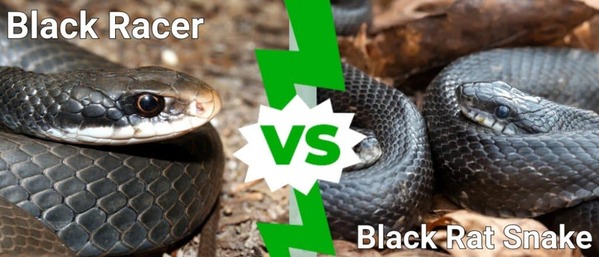When it comes to black snakes, two of the most commonly confused species are the black racer (Coluber constrictor) and the black rat snake (Pantherophis obsoletus). Both are sleek, non-venomous snakes found throughout North America, but their differences are more significant than meets the eye. This article dives into their distinctions, behaviors, habitats, and much more, helping you identify and understand these fascinating creatures.

The black racer snake is known for its smooth, shiny scales that give it a sleek appearance. Its body is uniformly black with a white chin, and its eyes are noticeably larger, giving it a sharp, alert look. Adult black racers typically measure 3 to 5 feet in length.
In contrast, the black rat snake has keeled (ridged) scales, giving it a duller, rougher texture. While adults are also predominantly black, they often retain faint white or gray markings on their bellies or sides. Black rat snakes are typically larger, growing up to 6 to 8 feet, making them one of the longest snakes in North America.
As its name suggests, the black racer snake is incredibly fast. It relies on its speed to escape predators and catch prey. Black racers are highly active during the day and are known for their nervous temperament. If threatened, they might dart away quickly or display defensive behaviors like hissing and striking, but they rarely bite.
The black rat snake, on the other hand, is more deliberate and stealthy. It’s an excellent climber and often found in trees searching for bird nests. Unlike the racer, the rat snake is calmer and more likely to freeze or curl into a defensive posture when confronted.
Black racers prefer open areas like grasslands, fields, and the edges of forests. They are commonly found in southeastern and eastern parts of the United States. These snakes thrive in sunny environments where they can stay warm and hunt.
Black rat snakes are more adaptable and are found in forests, farmlands, wetlands, and even suburban areas. Their ability to climb trees allows them to exploit a range of habitats. They are widespread across the eastern and central United States.
Black racers are opportunistic hunters with a diverse diet. They primarily feed on insects, small mammals, amphibians, and other reptiles, including smaller snakes. Their active hunting style involves chasing and overpowering prey.
Black rat snakes specialize in controlling rodent populations, earning them the nickname "farmer's friend." They also consume bird eggs, nestlings, and small mammals. Unlike racers, rat snakes use constriction to subdue their prey.
Neither the black racer nor the black rat snake is venomous, making them harmless to humans. However, their defensive behaviors differ:
Black racers might strike if provoked but rarely cause harm.
Black rat snakes, being calmer, usually rely on fleeing or playing dead rather than striking.
Both species are beneficial for pest control and play essential roles in their ecosystems.
| Feature | Black Racer | Black Rat Snake |
|---|---|---|
| Appearance | Smooth, shiny scales; smaller | Keeled scales; larger |
| Behavior | Fast, nervous, active hunter | Calm, stealthy, climbs trees |
| Size | 3-5 feet | 6-8 feet |
| Diet | Insects, reptiles, mammals | Rodents, bird eggs, nestlings |
| Habitat | Open fields, grasslands | Forests, farmlands, wetlands |
Black Racers: Despite their speed, black racers are not great climbers compared to rat snakes. They are also known to vibrate their tails in leaves to mimic rattlesnakes.
Black Rat Snakes: These snakes can hibernate in large groups during winter, sometimes sharing dens with other snake species, including venomous ones like rattlesnakes.
No, neither species is dangerous. They are non-venomous and generally avoid human contact.
Black racers are significantly faster, earning them their name.
While both species might compete for similar prey, direct confrontations are rare. Black racers may eat smaller snakes, but they usually avoid adult black rat snakes.
Understanding the differences between black racer snakes and black rat snakes can help you appreciate their unique roles in nature. While the racer dazzles with its speed and agility, the rat snake impresses with its climbing prowess and pest control abilities. Both snakes are crucial for maintaining ecological balance, making them valuable allies in our natural world.
Whether you encounter a black racer darting across a field or a black rat snake lounging in a tree, remember that these non-venomous reptiles pose no threat and play an essential role in keeping ecosystems healthy.
animal tags: Black-Racer Black-Rat-Snake
We created this article in conjunction with AI technology, then made sure it was fact-checked and edited by a Animals Top editor.